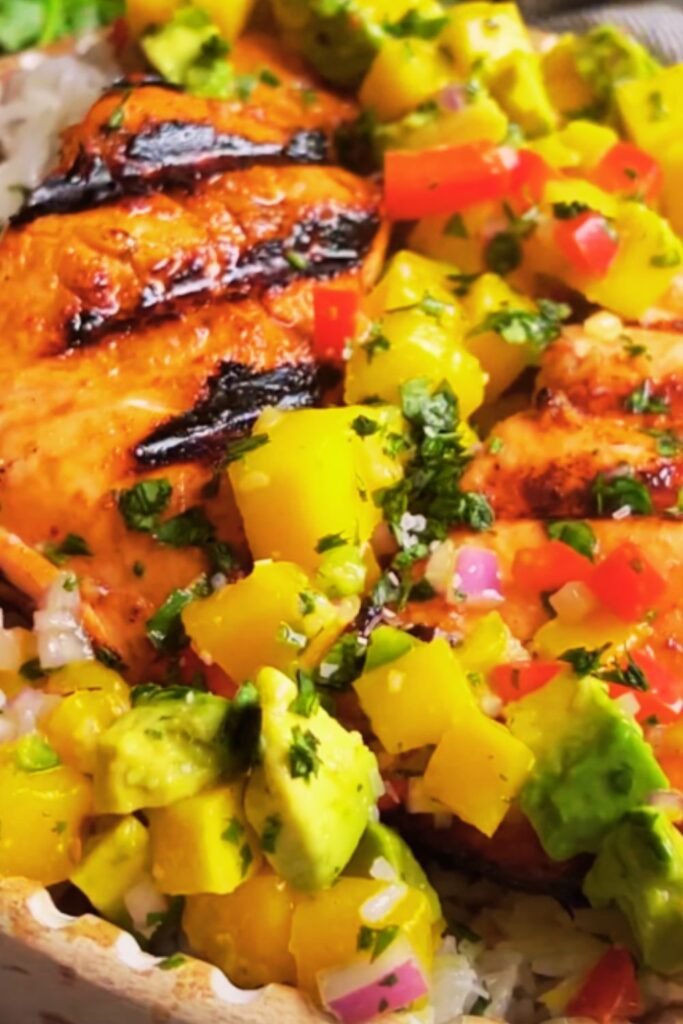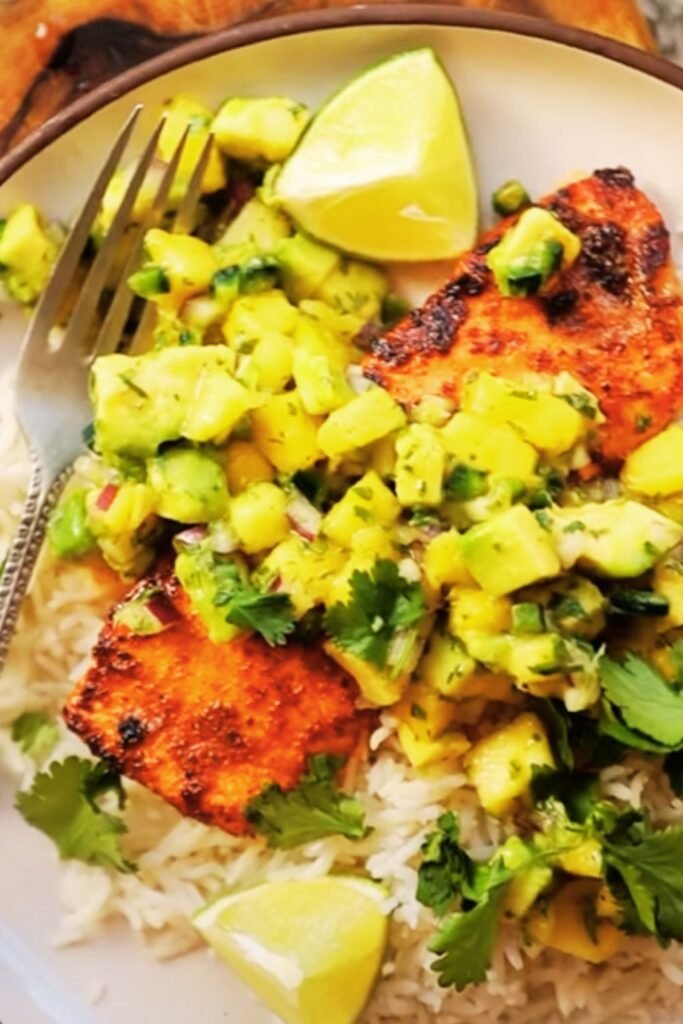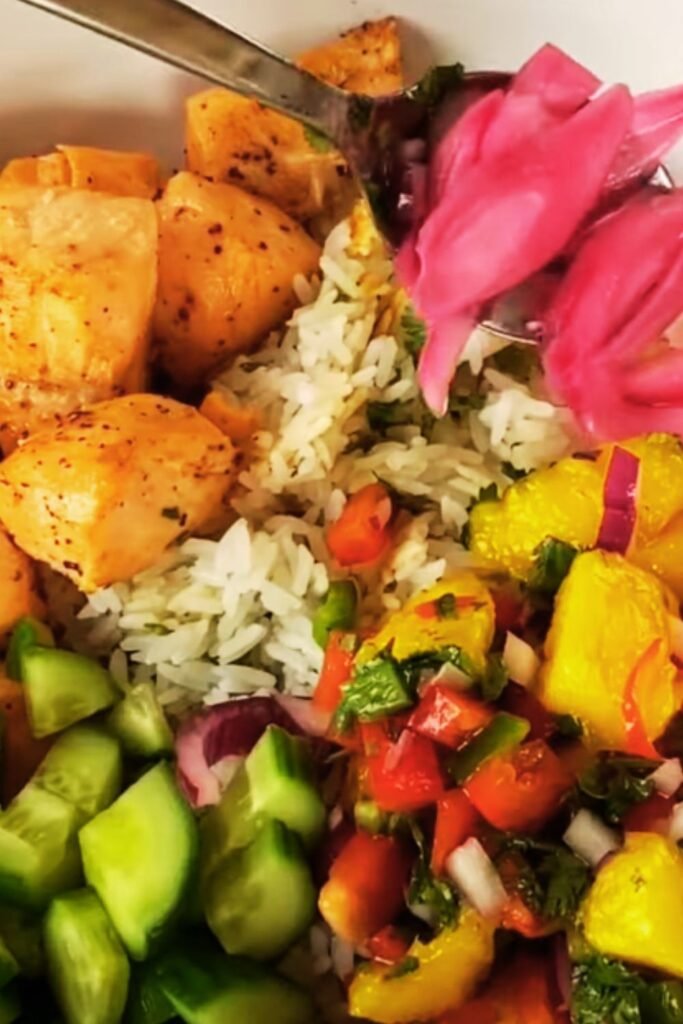When I first discovered the magical combination of salmon and mango salsa, my dinner routine was completely transformed. This dish brings together the rich, buttery flavor of perfectly cooked salmon with the bright, tropical notes of fresh mango salsa, creating a meal that’s both sophisticated and surprisingly simple to prepare.
The beauty of salmon with mango salsa lies in its versatility and the way contrasting flavors complement each other. The omega-3 rich salmon provides a hearty, satisfying protein base, while the mango salsa adds a refreshing sweetness that cuts through the fish’s natural richness. This combination not only tastes incredible but also delivers impressive nutritional benefits that make it a standout choice for health-conscious home cooks.
Understanding the Perfect Salmon Selection
Choosing the right salmon makes all the difference in this dish. I’ve learned through countless cooking experiences that not all salmon varieties work equally well with tropical fruit salsas.
Fresh vs. Frozen Salmon:
- Fresh salmon offers the best texture and flavor absorption
- Frozen salmon works well when properly thawed and patted dry
- Look for firm flesh with a bright, translucent appearance
- Avoid salmon with a strong fishy odor or dull coloring
Best Salmon Varieties for Mango Salsa:
- Atlantic Salmon: Rich, buttery texture that pairs beautifully with sweet mango
- King Salmon: Premium choice with high fat content and robust flavor
- Coho Salmon: Milder taste that lets the mango salsa shine
- Sockeye Salmon: Firm texture with a more pronounced salmon flavor
Essential Ingredients Breakdown
Creating the perfect salmon with mango salsa requires understanding each component’s role in the final dish. Here’s what I consider essential:
For the Salmon:
- 4 salmon fillets (6 oz each)
- 2 tablespoons olive oil
- 1 teaspoon kosher salt
- ½ teaspoon black pepper
- 1 teaspoon garlic powder
- ½ teaspoon paprika
For the Mango Salsa:
- 2 ripe mangoes, diced
- ½ red bell pepper, finely chopped
- ¼ red onion, minced
- 1 jalapeño pepper, seeded and minced
- ¼ cup fresh cilantro, chopped
- Juice of 2 limes
- 1 tablespoon honey
- ½ teaspoon salt

Nutritional Benefits and Health Information
| Nutrient | Salmon (6 oz) | Mango Salsa (½ cup) | Combined Serving |
|---|---|---|---|
| Calories | 354 | 45 | 399 |
| Protein | 53g | 1g | 54g |
| Omega-3 Fatty Acids | 2.3g | 0g | 2.3g |
| Vitamin C | 0mg | 35mg | 35mg |
| Vitamin A | 150 IU | 1,080 IU | 1,230 IU |
| Potassium | 628mg | 156mg | 784mg |
| Fiber | 0g | 2g | 2g |
| Healthy Fats | 20g | 0.3g | 20.3g |
This combination provides an excellent source of heart-healthy omega-3 fatty acids, high-quality protein, and essential vitamins. The mango contributes significant vitamin C and beta-carotene, while the salmon delivers premium protein and beneficial fats.
Step-by-Step Cooking Instructions
Preparing the Mango Salsa
I always start with the salsa because it benefits from resting time to allow flavors to meld together.
- Select and prepare mangoes: Choose mangoes that yield slightly to pressure but aren’t mushy. Peel and dice into ¼-inch cubes.
- Prepare vegetables: Finely dice the red bell pepper and red onion. Remove seeds from jalapeño and mince finely.
- Combine ingredients: In a medium bowl, gently fold together mango, bell pepper, onion, jalapeño, and cilantro.
- Add citrus and seasoning: Squeeze fresh lime juice over the mixture, drizzle with honey, and season with salt. Stir gently to combine.
- Rest the salsa: Let the mixture sit at room temperature for 30 minutes to allow flavors to develop.
Cooking the Salmon
Pan-Seared Method:
- Prepare salmon: Pat fillets dry with paper towels and season both sides with salt, pepper, garlic powder, and paprika.
- Heat the pan: Warm olive oil in a large skillet over medium-high heat until shimmering.
- Cook salmon: Place fillets skin-side up in the pan. Cook for 4-5 minutes without moving them.
- Flip carefully: Turn salmon using a thin spatula and cook for an additional 3-4 minutes.
- Check doneness: Internal temperature should reach 145°F (63°C) for food safety.
Grilled Method:
- Preheat grill: Heat to medium-high temperature and oil the grates.
- Season salmon: Apply the same seasoning blend as the pan-seared method.
- Grill carefully: Cook for 4-5 minutes per side, creating beautiful grill marks.
- Rest before serving: Let salmon rest for 2-3 minutes after cooking.

Cooking Temperature and Timing Guide
| Cooking Method | Temperature | Time Per Side | Internal Temp |
|---|---|---|---|
| Pan-Seared | Medium-High | 4-5 minutes | 145°F |
| Grilled | Medium-High | 4-5 minutes | 145°F |
| Baked | 400°F | 12-15 minutes | 145°F |
| Broiled | High | 6-8 minutes | 145°F |
Flavor Variations and Customizations
Spice Level Adjustments:
- Mild: Remove jalapeño seeds and membranes
- Medium: Include some jalapeño seeds
- Hot: Add serrano pepper or habanero
- Extra Hot: Include ghost pepper (use sparingly)
Fruit Substitutions:
- Pineapple chunks for tropical sweetness
- Peach slices for summer variation
- Papaya cubes for exotic twist
- Avocado chunks for creamy texture
Herb Alternatives:
- Fresh mint for cooling effect
- Basil for aromatic complexity
- Parsley for mild freshness
- Dill for Scandinavian influence
Serving Suggestions and Accompaniments
The versatility of salmon with mango salsa allows for numerous serving options that complement the dish’s tropical nature.
Starch Companions:
- Coconut rice pilaf
- Quinoa with lime zest
- Roasted sweet potato wedges
- Wild rice medley
- Cauliflower rice for low-carb option
Vegetable Pairings:
- Grilled asparagus with lemon
- Sautéed spinach with garlic
- Roasted Brussels sprouts
- Steamed broccoli with butter
- Mixed green salad with citrus vinaigrette
Sauce Enhancements:
- Avocado crema
- Lime yogurt sauce
- Chipotle aioli
- Cilantro-lime butter
- Coconut curry sauce

Storage and Meal Prep Tips
Fresh Storage:
- Refrigerate cooked salmon for up to 3 days
- Store mango salsa separately for up to 2 days
- Keep components in airtight containers
Freezing Guidelines:
- Freeze cooked salmon for up to 3 months
- Freeze uncooked seasoned salmon for up to 6 months
- Don’t freeze fresh mango salsa (texture deteriorates)
Meal Prep Strategy:
- Prepare salsa components separately
- Season salmon fillets in advance
- Cook salmon fresh for best results
- Combine components just before serving
Troubleshooting Common Issues
Overcooked Salmon:
- Reduce cooking time by 1-2 minutes per side
- Use a meat thermometer for accuracy
- Remove from heat at 140°F (carries over to 145°F)
Watery Salsa:
- Drain excess liquid before serving
- Salt mango lightly and drain for 15 minutes
- Use less lime juice initially
Lack of Flavor:
- Season salmon more generously
- Add more lime juice and salt to salsa
- Let salsa rest longer for flavor development
Wine and Beverage Pairings
Non-Alcoholic Options:
- Sparkling water with lime
- Iced green tea with mint
- Fresh coconut water
- Cucumber-infused water
- Tropical fruit smoothies
Hot Beverages:
- Ginger tea
- Chamomile with honey
- Green tea with jasmine
- Herbal mint tea
Seasonal Adaptations
Summer Variations:
- Add fresh corn kernels to salsa
- Include cherry tomatoes
- Use fresh peaches instead of mango
- Serve chilled for hot weather
Winter Modifications:
- Use frozen mango (thawed and drained)
- Add pomegranate seeds for color
- Include diced apple for crunch
- Serve warm with roasted vegetables
Q&A Section
Q: How do I know when my salmon is perfectly cooked? The salmon should flake easily with a fork and reach an internal temperature of 145°F. The flesh should be opaque throughout with a slightly pink center. Overcooked salmon becomes dry and tough, while undercooked salmon feels mushy and translucent.
Q: Can I make the mango salsa ahead of time? Yes, but I recommend making it no more than 2 hours before serving for the best texture and flavor. The lime juice will start to break down the mango if left too long, making the salsa watery.
Q: What’s the best way to dice a mango? Cut the mango lengthwise on either side of the pit, score the flesh in a crosshatch pattern without cutting through the skin, then push the skin inside-out and cut off the cubes. This method gives you uniform pieces perfect for salsa.
Q: Can I substitute frozen salmon for fresh? Absolutely! Just make sure to thaw it completely in the refrigerator overnight and pat it very dry before cooking. Frozen salmon can be just as delicious as fresh when properly handled.
Q: Why is my salmon sticking to the pan? This usually happens when the pan isn’t hot enough or the salmon is moved too early. Make sure your pan is properly preheated and don’t flip the salmon until it releases easily from the surface.
Q: How spicy should the jalapeño make the salsa? The heat level depends on your preference, but I typically remove all seeds and membranes for a mild warmth that enhances rather than overwhelms the other flavors. You can always add more heat with additional peppers.
Q: Can I use canned mango for the salsa? Fresh mango is always preferred for the best texture and flavor, but canned mango works in a pinch. Just make sure to drain it well and pat dry to prevent excess liquid in your salsa.
Q: What side dishes work best with this meal? I love serving this with coconut rice, grilled vegetables, or a simple green salad. The key is choosing sides that complement rather than compete with the tropical flavors of the mango salsa.
This salmon with mango salsa recipe has become one of my go-to meals for both casual weeknight dinners and special occasions. The combination of rich, flaky salmon with bright, tropical salsa creates a restaurant-quality dish that’s surprisingly simple to prepare at home. The nutritional benefits, combined with the incredible flavor profile, make this a recipe I return to again and again.
The key to success lies in selecting quality salmon, preparing fresh salsa with ripe mangoes, and not overcooking the fish. With these fundamentals in place, you’ll create a memorable meal that brings the flavors of the tropics to your dining table.